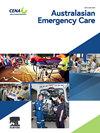Gender bias in text-to-image generative artificial intelligence depiction of Australian paramedics and first responders
IF 2.1
4区 医学
Q2 EMERGENCY MEDICINE
引用次数: 0
Abstract
Introduction
In Australia, almost 50 % of paramedics are female yet they remain under-represented in stereotypical depictions of the profession. The potentially transformative value of generative artificial intelligence (AI) may be limited by stereotypical errors, misrepresentations and bias. Increasing use of text-to-image generative AI, like DALL-E 3, could reinforce gender and ethnicity biases and, therefore, is important to objectively evaluate.
Method
In March 2024, DALL-E 3 was utilised via GPT-4 to generate a series of individual and group images of Australian paramedics, ambulance officers, police officers and firefighters. In total, 82 images were produced including 60 individual-character images, and 22 multiple-character group images. All 326 depicted characters were independently analysed by three reviewers for apparent gender, age, skin tone and ethnicity.
Results
Among first responders, 90.8 % (N = 296) were depicted as male, 90.5 % (N = 295) as Caucasian, 95.7 % (N = 312) as a light skin tone, and 94.8 % (N = 309) as under 55 years of age. For paramedics and police the gender distribution was a statistically significant variation from that of actual Australian workforce data (all p < 0.001). Among the images of individual paramedics and ambulance officers (N = 32), DALL-E 3 depicted 100 % as male, 100 % as Caucasian and 100 % with light skin tone.
Conclusion
Gender and ethnicity bias is a significant limitation for text-to-image generative AI using DALL-E 3 among Australian first responders. Generated images have a disproportionately high misrepresentation of males, Caucasians and light skin tones that are not representative of the diversity of paramedics in Australia today.
澳大利亚护理人员和急救人员的文本到图像生成人工智能描述中的性别偏见。
导读:在澳大利亚,近50%的护理人员是女性,但她们在职业的刻板印象中仍然代表性不足。生成式人工智能(AI)的潜在变革价值可能会受到刻板错误、虚假陈述和偏见的限制。越来越多地使用文本到图像的生成人工智能,如dall - e3,可能会加强性别和种族偏见,因此,客观评估是很重要的。方法:于2024年3月,利用DALL-E 3通过GPT-4生成一系列澳大利亚护理人员、救护人员、警察和消防员的个人和群体图像。共生成图像82张,其中单字图像60张,多字组图像22张。所有326个描绘的角色都由三名评论者独立分析,包括表面性别、年龄、肤色和种族。结果:在第一反应者中,90.8% (N = 296)为男性,90.5% (N = 295)为白种人,95.7% (N = 312)为浅肤色,94.8% (N = 309)为55岁以下。对于护理人员和警察,性别分布在统计上与澳大利亚实际劳动力数据有显著差异(所有p结论:性别和种族偏见是澳大利亚急救人员使用dall - e3进行文本到图像生成人工智能的重大限制。生成的图像对男性、白种人和浅肤色的歪曲程度过高,不能代表当今澳大利亚护理人员的多样性。
本文章由计算机程序翻译,如有差异,请以英文原文为准。
求助全文
约1分钟内获得全文
求助全文
来源期刊

Australasian Emergency Care
Nursing-Emergency Nursing
CiteScore
3.30
自引率
5.60%
发文量
82
审稿时长
37 days
期刊介绍:
Australasian Emergency Care is an international peer-reviewed journal dedicated to supporting emergency nurses, physicians, paramedics and other professionals in advancing the science and practice of emergency care, wherever it is delivered. As the official journal of the College of Emergency Nursing Australasia (CENA), Australasian Emergency Care is a conduit for clinical, applied, and theoretical research and knowledge that advances the science and practice of emergency care in original, innovative and challenging ways. The journal serves as a leading voice for the emergency care community, reflecting its inter-professional diversity, and the importance of collaboration and shared decision-making to achieve quality patient outcomes. It is strongly focussed on advancing the patient experience and quality of care across the emergency care continuum, spanning the pre-hospital, hospital and post-hospital settings within Australasia and beyond.
 求助内容:
求助内容: 应助结果提醒方式:
应助结果提醒方式:


